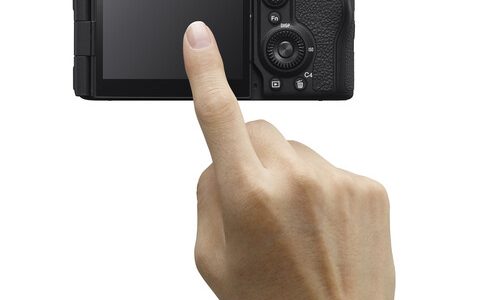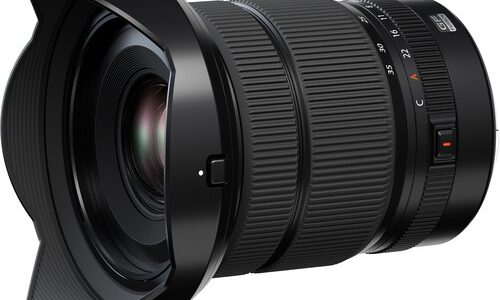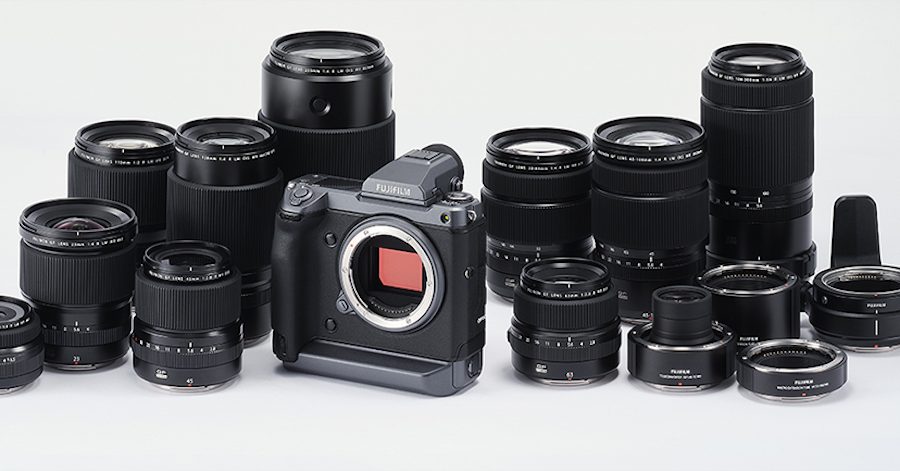

Part 1: Overview

The camera market as a whole is contracting, but mirrorless is where the new growth is occurring.
As the market for “serious cameras” contracts in the face of phone photography, essentially all of the major camera manufacturers have put their efforts into the development of mirrorless bodies and their associated systems of lenses and accessories. The only new DSLRs to reach the market since the Nikon D850 in 2017 have been derivative models focused almost entirely on cutting costs, while we have seen not only new mirrorless cameras and lenses, but multiple new systems launched in that same time period.
As recently as the summer of 2018, there were only three viable mirrorless systems (plus a couple of oddities on the fringes of the market), offered by four manufacturers since Olympus and Panasonic shared Micro 4/3. Each system used a different primary sensor size, ranging from Micro 4/3, similar to 110 film, up to 24x36mm (35mm full frame). In the past year, two entirely new 24x36mm systems have launched, plus the participation of Panasonic and Sigma has brought Leica’s L-mount system from obscurity to viability. It has become clear that Fujifilm is serious about their 33x44mm “small medium format” system, as a single body with a few lenses has become three bodies with an expanding lens line.
As of the summer of 2019, a well-stocked camera store will offer seven or more mirrorless systems from six to eight manufacturers, any of which could fit an individual photographer’s needs. There are four different sensor sizes ranging from Micro 4/3 to small medium format. A quick scan of B&H Photo’s website reveals 54 distinct mirrorless bodies using ten lens mounts and ranging in price from the $348 Sony Alpha a5100 to the $9999 Fujifilm GFX 100. You could spend under $500 for a body, lens, memory card and the accessories to begin photographing, or you could spend over $20,000.
How is a photographer to make sense of it all? First of all, a few of those ten mounts are unlikely to be of interest to the average Luminous Landscape reader. Sigma still has a couple of bodies and lenses using their older SD mount on the market, which is a dead end with their commitment to the L mount with Leica and Panasonic. Canon’s EOS-M system primarily includes low-end kit type lenses and will be too confining for most serious photographers – Canon’s energy is in the full-frame EOS-R system. Finally, Hasselblad’s X1D II is expensive enough, at $5750 for a body and with lenses starting at $2700, to be outside of many budgets. Fujifilm’s medium format GFX system is enough more affordable to include more seriously in a roundup of the mirrorless options.

The GFX 100 with a collection of GF lenses
Second, there are really only three basic levels of image quality, with a fourth probably occupied only by the $9999 Fujifilm GFX 100. At the low end, Micro 4/3 is handicapped both by its small sensor size and the age of the available sensors (the newest Micro 4/3 sensor was introduced in 2015, and doesn’t feature the back-side illumination that is a standard feature of modern sensors). Canon’s low-end EOS-M system uses a Canon-manufactured sensor that doesn’t have the dynamic range of the ubiquitous Sony sensors, and is held back by the quality of its lenses. The EOS-M system is probably not worth considering for most people reading this, although it can be a worthwhile camera for a young photographer or as a snapshot camera, especially at a very low price.
Micro 4/3 is a different story – compact, rugged bodies with excellent image stabilization, some exceptional lenses and superb video capabilities in several models can be well worth the sacrifice in image quality, depending on the application. Both resolution and dynamic range are constrained compared to other formats, but that may matter less than other features, ruggedness and size. A few other cameras are well below 24 MP, generally due to specialized video features – their still image quality falls in this category, but they are primarily video cameras.
The second level of image quality is the ubiquitous 24 megapixel cameras, whether they are APS-C or full-frame. Of the 54 bodies on B&H’s website, about half of them are in this range. 19 use one of several variants of the two sizes of 24 MP Sony sensor, while a few newer APS-C cameras from Fujifilm use a related 26 MP sensor. Canon’s EOS-RP is a 26 MP full-frame camera, while their EOS-R uses a 30 MP sensor. Both fall broadly into the 24 MP image quality class, with the added dynamic range of the newer Sony sensors trading off against the EOS-R’s additional pixels
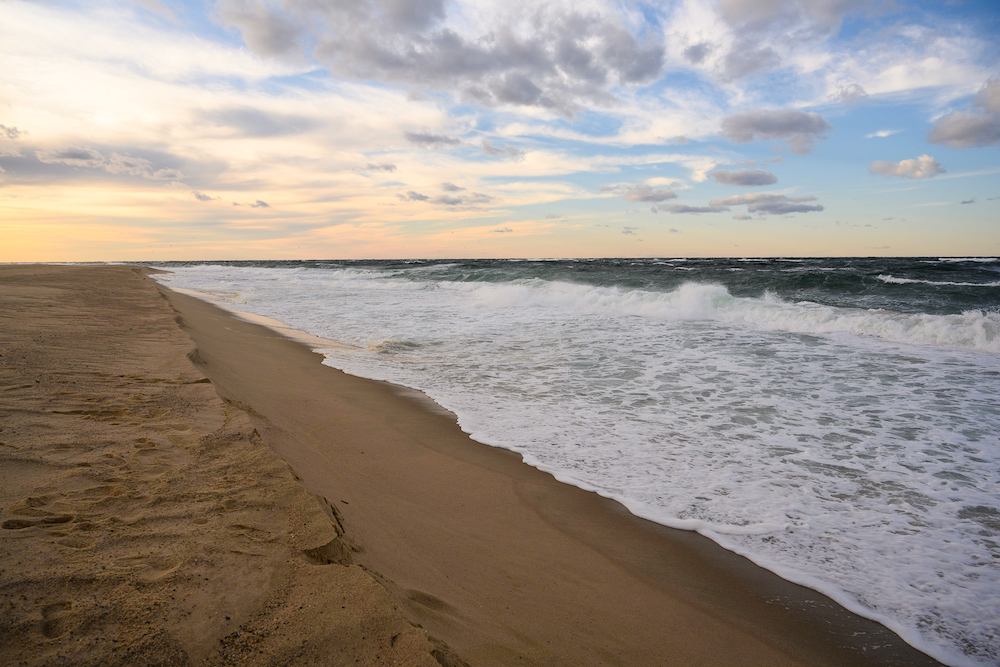
. Race Point Beach, Provincetown, MA in winter – Nikon Z7, and every grain of sand is visible.
The third image quality class is the “pixel monsters”. With exceptional resolution and dynamic range, Sony’s A7r II, III and IV, Nikon’s Z7 (and D850 DSLR) and Panasonic’s S1r provide the highest image quality available in any camera that doesn’t use a medium format sensor. The older 50 MP medium format sensor in the Fujifilm GFX 50 S and GFX 50 R and the Hasselblad X1D and X1D II is very similar in overall image quality to the 40+ MP 24x36mm cameras.
Will the new Sony A7r IV noticeably exceed the image quality of the other cameras in this class? Very few people have handled one yet, and there is no software to process the raw files, so there is no way to tell (using a 61MP camera in JPEG mode is like picking up groceries in a Ferrari – it works, but why?). The increase in pixel count is largely insignificant (~15% linear resolution increase over other “pixel monsters”), and Sony’s specifications don’t indicate a huge leap in any other area of image quality, so the best guess at this point is that it will probably land at the top of this class, but still well within the class.
While I have not used a Fujifilm GFX 100, and have not seen a print made from its image files, the specifications indicate that it has the potential to occupy an image quality class of its own, joined only by future cameras that use the same 100 MP medium format sensor, at least until some sensor not on anyone’s public roadmap is released. Not only does it offer a meaningful increase in resolution over every other camera on the market except the exotic Phase One IQ4 150 ( the GFX 100 offers a ~33% increase in linear resolution over ~50 MP cameras), it also offers very wide dynamic range, along with 16-bit output to preserve that dynamic range.
Does this mean that a GFX 100 is the right choice for every photographer who can afford one, and that nobody should ever use Micro 4/3? NO. The extra pixels only make a difference on a print large enough to see the resolution increase (and almost never on a screen). As a matter of fact, 4K (8 MP) and even 5K (14 MP) screens have fewer pixels than pretty much any camera on today’s market, and the very rare 8K screens are around 33 MP, still not enough to display an image from a 40+ MP camera full-size. Up to a 12×18” print, pixels pretty much don’t matter, apart from using an ancient camera or something that is primarily a video camera. Even the old 16 MP Micro 4/3 sensor is a more capable imaging device than most 35mm film ever was, and very capable of making an excellent 12×18” print. The only caveat is that the sensors in the lowest quality class often don’t have the dynamic range of other sensors. If you expose to hold important shadow details, the highlights may blow, and conversely, if you hold in the highlights, muddy shadows may be the price you pay.
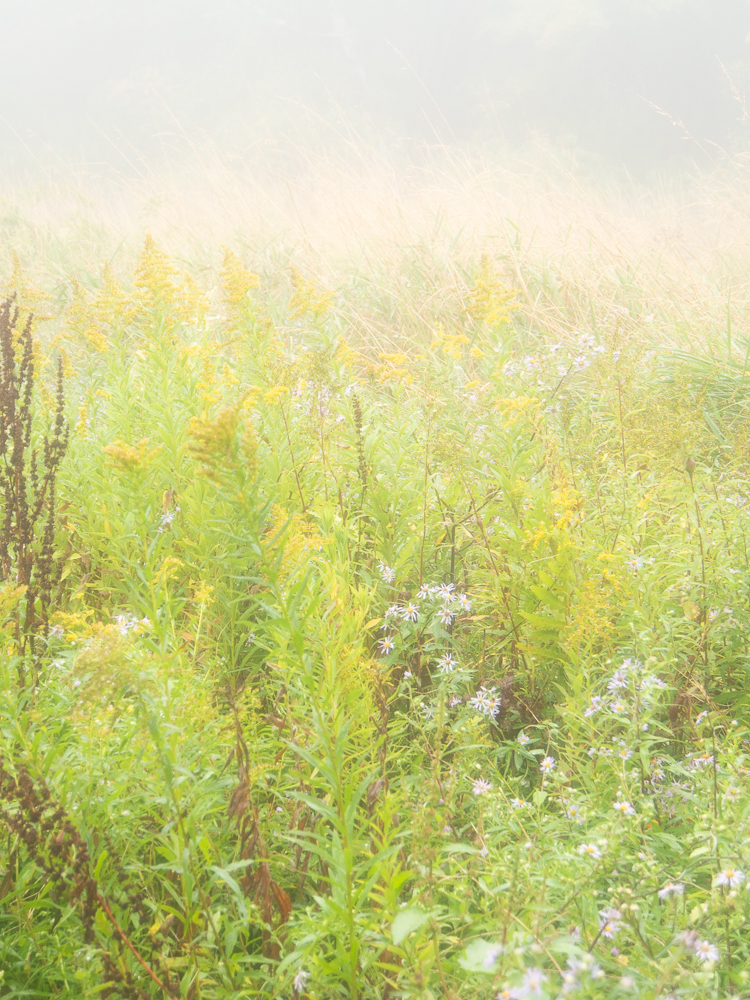
Not only Micro 4/3, but old Micro 4/3 (original E-M5), and it doesn’t matter – I’ve printed this as large as 24×32”. Resolution doesn’t matter much, and it has about 4 stops of dynamic range
As you move up to making prints in the range of 16×24”, the maximum size the largest desktop printers are capable of, the difference between the lowest image quality class and cameras using a modern 24 MP or higher sensor often becomes apparent. I have images shot on Micro 4/3 that work very well at 16×24”, and I have high-detail images that are pushing the edge of what the file is capable of at that size. I have one particular very misty image that can go significantly larger than that, despite the low capture resolution. The image also has a very narrow dynamic range, so that limitation of the sensor is not apparent.

24 MP (Fujifilm X-T2) – I have newer redwood images with higher resolution, but I haven’t seen light like this again – and it works.
A really good image from any modern 24 MP sensor with a good to excellent lens will print beautifully at 16×24”, regardless of the subject matter. These sensors have very good to excellent dynamic range and color reproduction, and they are as capable as most medium format film ever was. I have printed scanned 6×6 cm transparencies I captured with a Hasselblad and a Zeiss lens, and they don’t quite have the overall image quality of something like a Fujifilm X-T2 with a really good lens at low ISO. It is possible that an exceptional scanner (an Imacon, a drum scanner or using a very high resolution camera as a scanner), could bring medium format film into competition with 24 MP digital.
Once the print size reaches 24×36” or so, the pixel monsters begin to shine. I was satisfied with 24×36” prints from 24 MP Fujifilm cameras – until I compared them to 24×36” prints from a 46 MP Nikon Z7! The detail the high-resolution cameras capture is astonishing, and it takes a really large print to see it all. Every mirrorless camera over 40 MP also offers superb dynamic range and color reproduction. I ran into the limits of my 24” wide printer while the Z7 files still have more to give – I have a couple of images where I crop to a longer aspect ratio, and they print beautifully in the vicinity of 24×45”, standing up to very close inspection. Can the pixel monsters print gallery-quality 40×60” prints? I don’t know, because I don’t have regular access to a 44” printer . The only film format I have ever worked with that offers close to this image quality is 4×5”. There is probably somewhat more detail in a really good 4×5” scan, but there is also grain to be concerned with, and neither the highlights nor the shadows will hold as well as they do in a 40+ MP raw file.
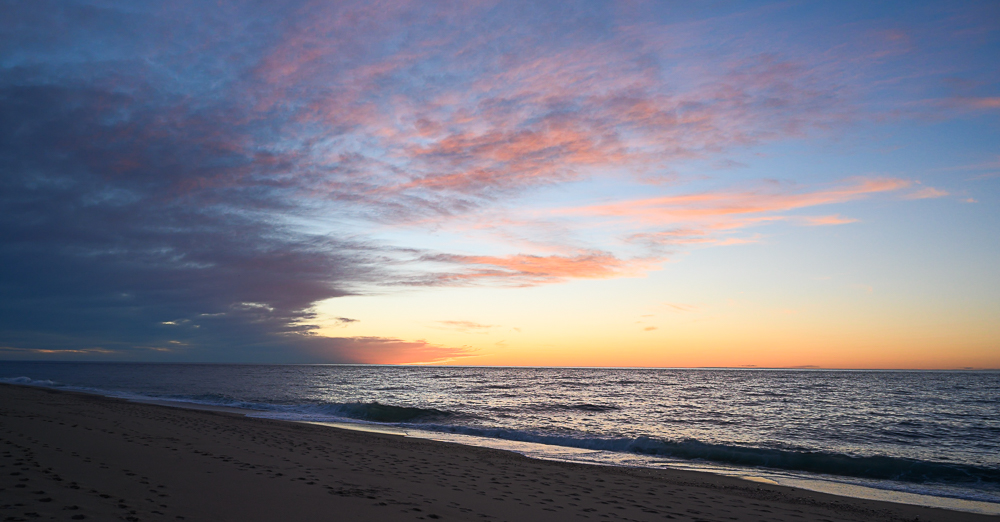
46 MP from the Nikon Z7 – this prints 24×46” no problem (cropped) – it’s shown installed below.
In order to separate the GFX 100 from the pack, the finished product will almost certainly have to be a print well over 24×36”. In order to really appreciate the quality the GFX 100 is capable of, a 44” or 60” wide printer will be essential. This also means making room for the printer in a home, office or studio. A 44” printer is approximately the size of an upright piano, and a 60” printer is the size of a full-size sofa or a baby grand. Spaces that can exhibit prints that large are also hard to find, and huge prints require specialized matting and framing, or they can be printed and stretched on canvas (in a large workshop).
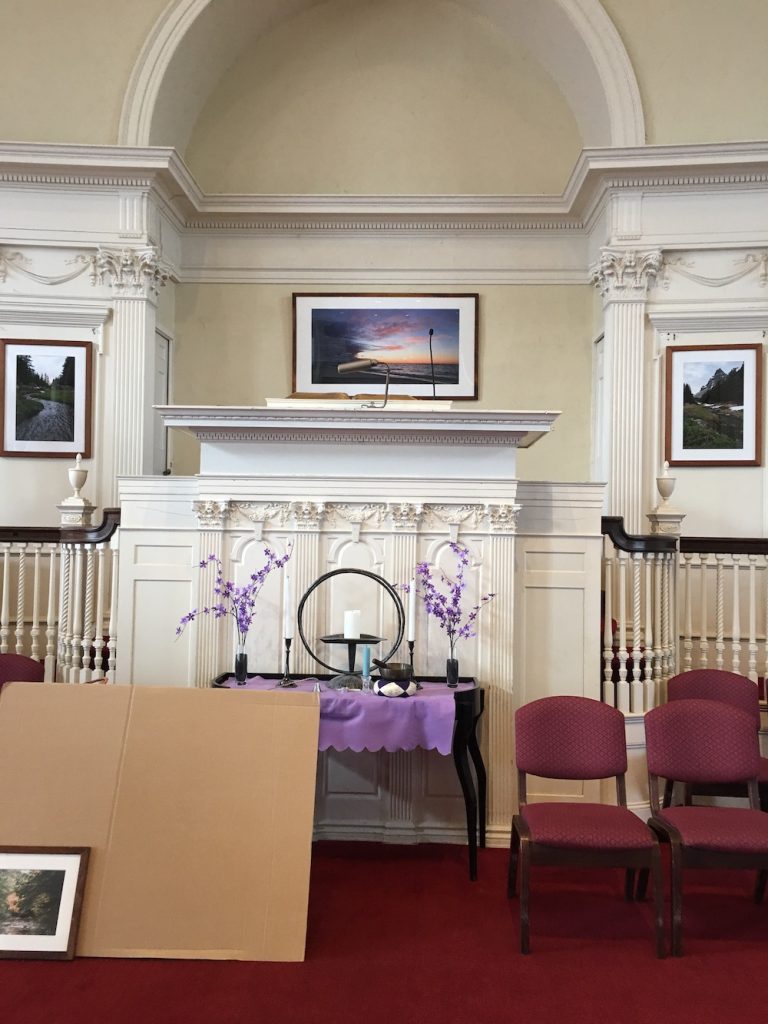
Installing a show in a space that really needs large images (the large print above the altar has an image area of 24×46”)
A honest evaluation of how you plan to use the images is essential to choosing a system. If your use is on screen, or printed on most desktop printers, there is no current interchangeable lens camera that should be ruled out because of resolution. Other aspects of image quality are worth considering before choosing Micro 4/3 – the dynamic range deficit is quite noticeable in tough situations. The advantages of Olympus’ superb image stabilizer and exceptional build quality or Panasonic’s video features may make the dynamic range sacrifice worthwhile, depending on what you’re shooting. Any modern 24 MP Sony sensor (Sony sensors are found in many manufacturers’ cameras, not just Sonys) or better will offer more than sufficient image quality in every regard.
If you plan to print on a 17” wide printer, for an image size around 16×24”, probably avoid anything less than a modern 24 MP camera – but there are many choices that will work.

A 60” Canon Pro-6000 – it weighs nearly 400 lbs. Even my Pro-2000 (24” version) is around 200 lbs.
Once you get into the big roll-fed printers, the 40+ MP cameras are their logical partners. If you have made the massive commitment to your images to invite an ugly 200 lb piece of furniture into your home or office, why not use its full capabilities?
In their most recent round of sensor introductions, Sony has done something very interesting. From APS-C up to a larger medium format sensor used by Phase One, many of the current generation of Sony sensors that will be used in cameras for the next few years have the same technology and pixel size/density. The 26 MP sensor in the Fujifilm X-T3 and X-T30, the 61 MP sensor in the Sony A7r IV, the 100 MP sensor in the Fujifilm GFX 100 and the 150 MP sensor in the Phase One IQ4 150 are all closely related – the difference between them is primarily in the physical size of the sensor (which determines the pixel count, since the pixels are all the same size) and, therefore, in the possible size of a print. The 24 MP full-frame sensor is much less dense than these sensors, while the 20 MP Micro 4/3 sensor is both somewhat more dense and a significant generation older.
All of these recommendations for matching camera type to print size depend on having a good to excellent lens on the camera. Lens selection will be mentioned further in the manufacturer summaries below, but perhaps the most egregious example is Sony vs. Fujifilm APS-C. The Sony A6400 and the Fujifilm X-T2 are, in most ways, comparable cameras. They use very similar if not identical 24 MP APS-C sensors (although Fujifilm uses an unusual color filter over the sensor). Their body features are similar, although many photographers prefer Fujifilm’s interface.

A sharp kit lens on a sharp subject… Ocotillo and a bunch of cacti, photographed with the 18-55 f2.8-4 Fujinon
The real difference comes in the kit lens. The most common lens bundled with the X-T2 is the beautiful little Fujinon 18-55 f2.8-4. It’s by far the best APS-C kit lens on the market, very competitive with upper-end zooms and many primes, and easily capable of helping the sensor show its stuff. Sony, on the other hand, chooses to include the atrocious 16-50 f3.5 pancake zoom. It’s even smaller than the already compact Fujinon, but that’s one of the few good things that can be said about it. There are certainly better lenses for Sony APS-C bodies, but most of the good ones are full-frame, and why not use a full-frame Sony body if you’re paying for and lugging full-frame lenses?
Dan Wells
August 2019

Lorem ipsum dolor sit amet, consectetur adipiscing elit, sed do eiusmod tempor incididunt ut labore et dolore magna aliqua. Ut enim ad minim veniam, quis nostrud exercitation ullamco laboris nisi ut aliquip ex ea commodo consequat. Duis aute irure dolor in reprehenderit in voluptate velit esse cillum dolore eu fugiat nulla pariatur. Excepteur sint occaecat cupidatat non proident, sunt in culpa qui officia deserunt mollit anim id est laborum.
Lorem ipsum dolor sit amet, consectetur adipiscing elit, sed do eiusmod tempor incididunt ut labore et dolore magna aliqua. Ut enim ad minim veniam, quis nostrud exercitation ullamco laboris nisi ut aliquip ex ea commodo consequat. Duis aute irure dolor in reprehenderit in voluptate velit esse cillum dolore eu fugiat nulla pariatur. Excepteur sint occaecat cupidatat non proident, sunt in culpa qui officia deserunt mollit anim id est laborum.
Lorem ipsum dolor sit amet, consectetur adipiscing elit, sed do eiusmod tempor incididunt ut labore et dolore magna aliqua. Ut enim ad minim veniam, quis nostrud exercitation ullamco laboris nisi ut aliquip ex ea commodo consequat. Duis aute irure dolor in reprehenderit in voluptate velit esse cillum dolore eu fugiat nulla pariatur. Excepteur sint occaecat cupidatat non proident, sunt in culpa qui officia deserunt mollit anim id est laborum.
Lorem ipsum dolor sit amet, consectetur adipiscing elit, sed do eiusmod tempor incididunt ut labore et dolore magna aliqua. Ut enim ad minim veniam, quis nostrud exercitation ullamco laboris nisi ut aliquip ex ea commodo consequat. Duis aute irure dolor in reprehenderit in voluptate velit esse cillum dolore eu fugiat nulla pariatur. Excepteur sint occaecat cupidatat non proident, sunt in culpa qui officia deserunt mollit anim id est laborum.

Lorem ipsum dolor sit amet, consectetur adipiscing elit, sed do eiusmod tempor incididunt ut labore et dolore magna aliqua. Ut enim ad minim veniam, quis nostrud exercitation ullamco laboris nisi ut aliquip ex ea commodo consequat. Duis aute irure dolor in reprehenderit in voluptate velit esse cillum dolore eu fugiat nulla pariatur. Excepteur sint occaecat cupidatat non proident, sunt in culpa qui officia deserunt mollit anim id est laborum.
Lorem ipsum dolor sit amet, consectetur adipiscing elit, sed do eiusmod tempor incididunt ut labore et dolore magna aliqua. Ut enim ad minim veniam, quis nostrud exercitation ullamco laboris nisi ut aliquip ex ea commodo consequat. Duis aute irure dolor in reprehenderit in voluptate velit esse cillum dolore eu fugiat nulla pariatur. Excepteur sint occaecat cupidatat non proident, sunt in culpa qui officia deserunt mollit anim id est laborum.
Lorem ipsum dolor sit amet, consectetur adipiscing elit, sed do eiusmod tempor incididunt ut labore et dolore magna aliqua. Ut enim ad minim veniam, quis nostrud exercitation ullamco laboris nisi ut aliquip ex ea commodo consequat. Duis aute irure dolor in reprehenderit in voluptate velit esse cillum dolore eu fugiat nulla pariatur. Excepteur sint occaecat cupidatat non proident, sunt in culpa qui officia deserunt mollit anim id est laborum.

Lorem ipsum dolor sit amet, consectetur adipiscing elit, sed do eiusmod tempor incididunt ut labore et dolore magna aliqua. Ut enim ad minim veniam, quis nostrud exercitation ullamco laboris nisi ut aliquip ex ea commodo consequat. Duis aute irure dolor in reprehenderit in voluptate velit esse cillum dolore eu fugiat nulla pariatur. Excepteur sint occaecat cupidatat non proident, sunt in culpa qui officia deserunt mollit anim id est laborum.

Lorem ipsum dolor sit amet, consectetur adipiscing elit, sed do eiusmod tempor incididunt ut labore et dolore magna aliqua. Ut enim ad minim veniam, quis nostrud exercitation ullamco laboris nisi ut aliquip ex ea commodo consequat. Duis aute irure dolor in reprehenderit in voluptate velit esse cillum dolore eu fugiat nulla pariatur. Excepteur sint occaecat cupidatat non proident, sunt in culpa qui officia deserunt mollit anim id est laborum.
Lorem ipsum dolor sit amet, consectetur adipiscing elit, sed do eiusmod tempor incididunt ut labore et dolore magna aliqua. Ut enim ad minim veniam, quis nostrud exercitation ullamco laboris nisi ut aliquip ex ea commodo consequat. Duis aute irure dolor in reprehenderit in voluptate velit esse cillum dolore eu fugiat nulla pariatur. Excepteur sint occaecat cupidatat non proident, sunt in culpa qui officia deserunt mollit anim id est laborum.
Lorem ipsum dolor sit amet, consectetur adipiscing elit, sed do eiusmod tempor incididunt ut labore et dolore magna aliqua. Ut enim ad minim veniam, quis nostrud exercitation ullamco laboris nisi ut aliquip ex ea commodo consequat. Duis aute irure dolor in reprehenderit in voluptate velit esse cillum dolore eu fugiat nulla pariatur. Excepteur sint occaecat cupidatat non proident, sunt in culpa qui officia deserunt mollit anim id est laborum.
Lorem ipsum dolor sit amet, consectetur adipiscing elit, sed do eiusmod tempor incididunt ut labore et dolore magna aliqua. Ut enim ad minim veniam, quis nostrud exercitation ullamco laboris nisi ut aliquip ex ea commodo consequat. Duis aute irure dolor in reprehenderit in voluptate velit esse cillum dolore eu fugiat nulla pariatur. Excepteur sint occaecat cupidatat non proident, sunt in culpa qui officia deserunt mollit anim id est laborum.

Lorem ipsum dolor sit amet, consectetur adipiscing elit, sed do eiusmod tempor incididunt ut labore et dolore magna aliqua. Ut enim ad minim veniam, quis nostrud exercitation ullamco laboris nisi ut aliquip ex ea commodo consequat. Duis aute irure dolor in reprehenderit in voluptate velit esse cillum dolore eu fugiat nulla pariatur. Excepteur sint occaecat cupidatat non proident, sunt in culpa qui officia deserunt mollit anim id est laborum.
Lorem ipsum dolor sit amet, consectetur adipiscing elit, sed do eiusmod tempor incididunt ut labore et dolore magna aliqua. Ut enim ad minim veniam, quis nostrud exercitation ullamco laboris nisi ut aliquip ex ea commodo consequat. Duis aute irure dolor in reprehenderit in voluptate velit esse cillum dolore eu fugiat nulla pariatur. Excepteur sint occaecat cupidatat non proident, sunt in culpa qui officia deserunt mollit anim id est laborum.

Lorem ipsum dolor sit amet, consectetur adipiscing elit, sed do eiusmod tempor incididunt ut labore et dolore magna aliqua. Ut enim ad minim veniam, quis nostrud exercitation ullamco laboris nisi ut aliquip ex ea commodo consequat. Duis aute irure dolor in reprehenderit in voluptate velit esse cillum dolore eu fugiat nulla pariatur. Excepteur sint occaecat cupidatat non proident, sunt in culpa qui officia deserunt mollit anim id est laborum.
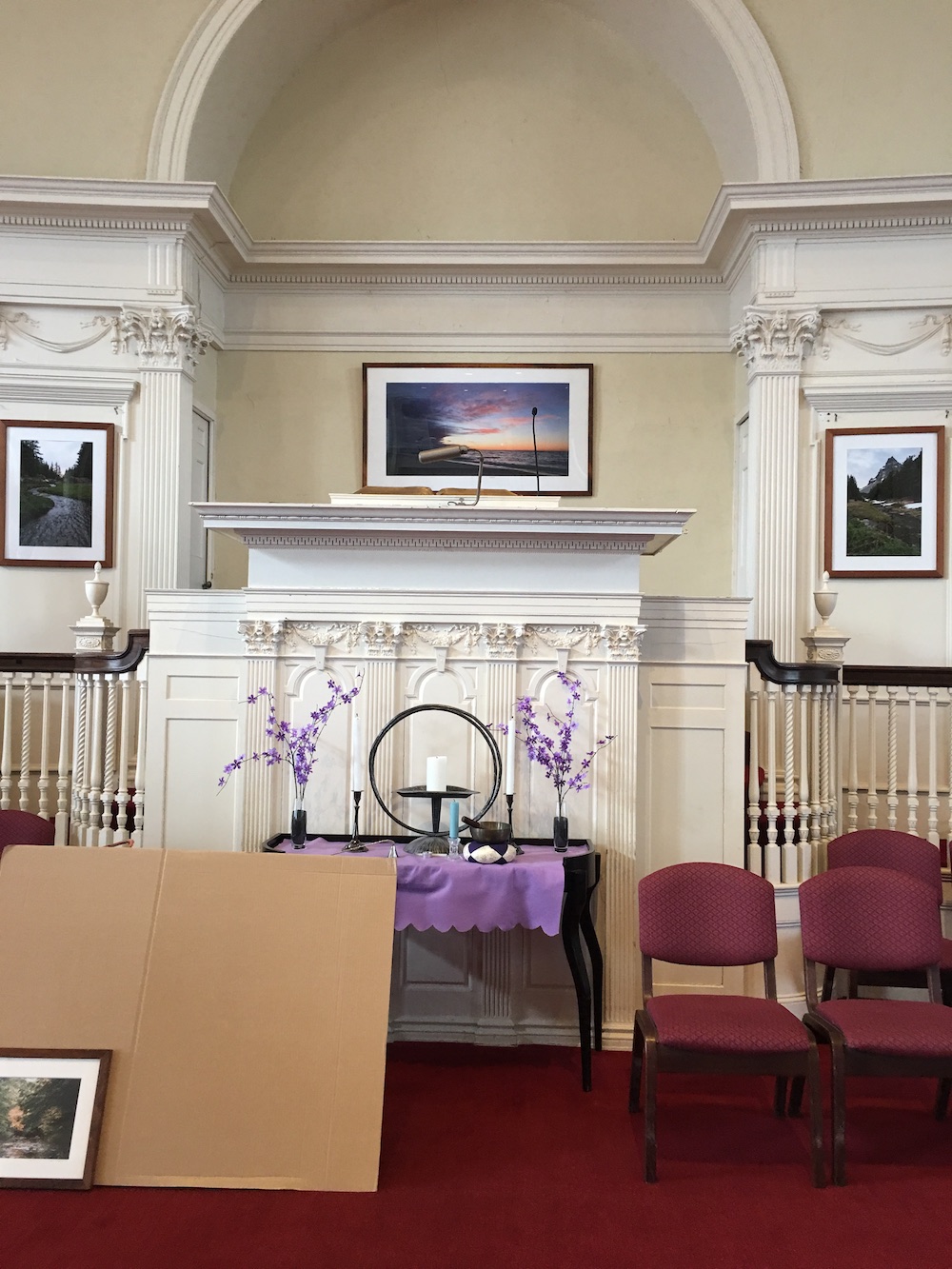
Lorem ipsum dolor sit amet, consectetur adipiscing elit, sed do eiusmod tempor incididunt ut labore et dolore magna aliqua. Ut enim ad minim veniam, quis nostrud exercitation ullamco laboris nisi ut aliquip ex ea commodo consequat. Duis aute irure dolor in reprehenderit in voluptate velit esse cillum dolore eu fugiat nulla pariatur. Excepteur sint occaecat cupidatat non proident, sunt in culpa qui officia deserunt mollit anim id est laborum.
Lorem ipsum dolor sit amet, consectetur adipiscing elit, sed do eiusmod tempor incididunt ut labore et dolore magna aliqua. Ut enim ad minim veniam, quis nostrud exercitation ullamco laboris nisi ut aliquip ex ea commodo consequat. Duis aute irure dolor in reprehenderit in voluptate velit esse cillum dolore eu fugiat nulla pariatur. Excepteur sint occaecat cupidatat non proident, sunt in culpa qui officia deserunt mollit anim id est laborum.
Lorem ipsum dolor sit amet, consectetur adipiscing elit, sed do eiusmod tempor incididunt ut labore et dolore magna aliqua. Ut enim ad minim veniam, quis nostrud exercitation ullamco laboris nisi ut aliquip ex ea commodo consequat. Duis aute irure dolor in reprehenderit in voluptate velit esse cillum dolore eu fugiat nulla pariatur. Excepteur sint occaecat cupidatat non proident, sunt in culpa qui officia deserunt mollit anim id est laborum.

Lorem ipsum dolor sit amet, consectetur adipiscing elit, sed do eiusmod tempor incididunt ut labore et dolore magna aliqua. Ut enim ad minim veniam, quis nostrud exercitation ullamco laboris nisi ut aliquip ex ea commodo consequat. Duis aute irure dolor in reprehenderit in voluptate velit esse cillum dolore eu fugiat nulla pariatur. Excepteur sint occaecat cupidatat non proident, sunt in culpa qui officia deserunt mollit anim id est laborum.
Lorem ipsum dolor sit amet, consectetur adipiscing elit, sed do eiusmod tempor incididunt ut labore et dolore magna aliqua. Ut enim ad minim veniam, quis nostrud exercitation ullamco laboris nisi ut aliquip ex ea commodo consequat. Duis aute irure dolor in reprehenderit in voluptate velit esse cillum dolore eu fugiat nulla pariatur. Excepteur sint occaecat cupidatat non proident, sunt in culpa qui officia deserunt mollit anim id est laborum.
Lorem ipsum dolor sit amet, consectetur adipiscing elit, sed do eiusmod tempor incididunt ut labore et dolore magna aliqua. Ut enim ad minim veniam, quis nostrud exercitation ullamco laboris nisi ut aliquip ex ea commodo consequat. Duis aute irure dolor in reprehenderit in voluptate velit esse cillum dolore eu fugiat nulla pariatur. Excepteur sint occaecat cupidatat non proident, sunt in culpa qui officia deserunt mollit anim id est laborum.
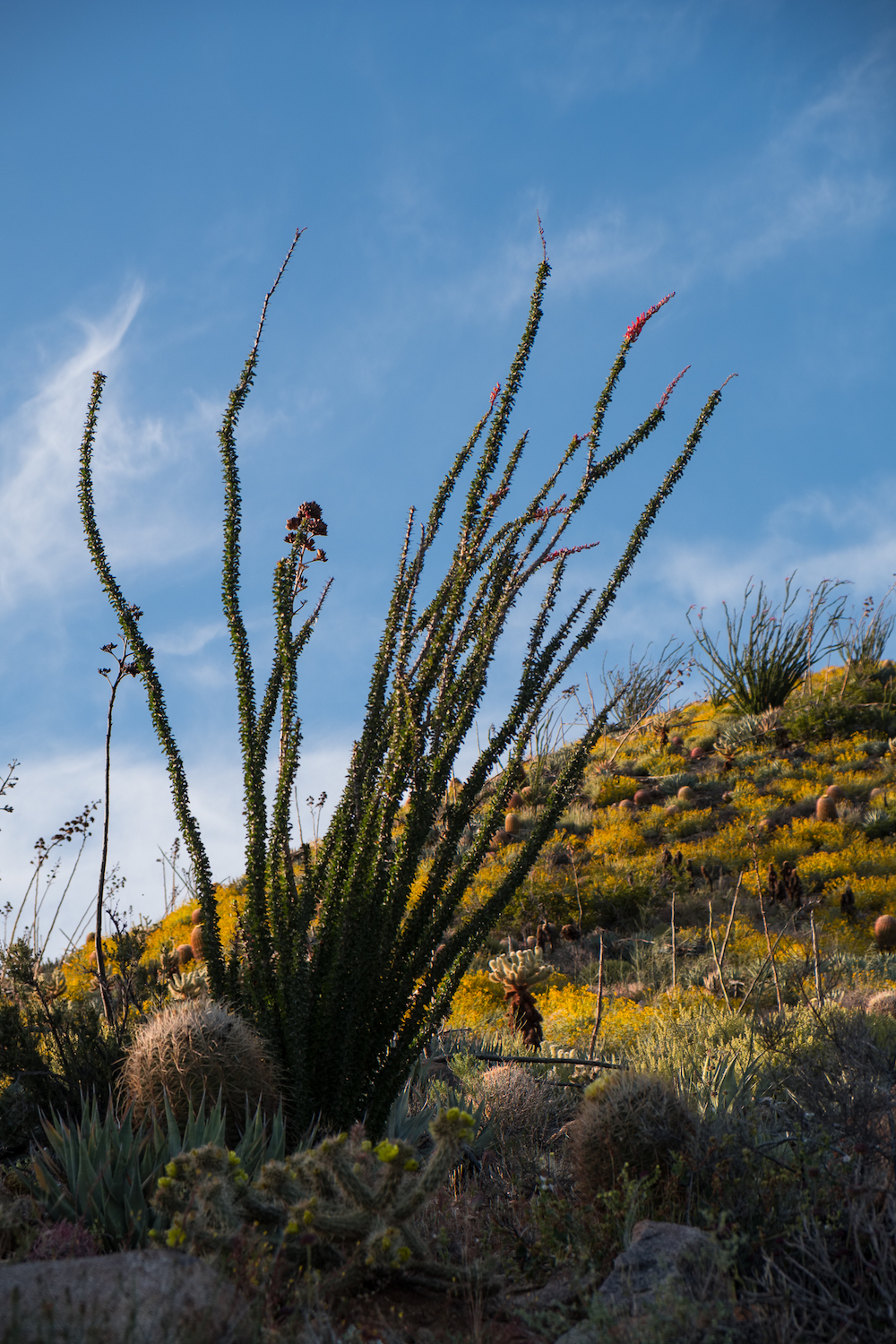
Lorem ipsum dolor sit amet, consectetur adipiscing elit, sed do eiusmod tempor incididunt ut labore et dolore magna aliqua. Ut enim ad minim veniam, quis nostrud exercitation ullamco laboris nisi ut aliquip ex ea commodo consequat. Duis aute irure dolor in reprehenderit in voluptate velit esse cillum dolore eu fugiat nulla pariatur. Excepteur sint occaecat cupidatat non proident, sunt in culpa qui officia deserunt mollit anim id est laborum.
Lorem ipsum dolor sit amet, consectetur adipiscing elit, sed do eiusmod tempor incididunt ut labore et dolore magna aliqua. Ut enim ad minim veniam, quis nostrud exercitation ullamco laboris nisi ut aliquip ex ea commodo consequat. Duis aute irure dolor in reprehenderit in voluptate velit esse cillum dolore eu fugiat nulla pariatur. Excepteur sint occaecat cupidatat non proident, sunt in culpa qui officia deserunt mollit anim id est laborum.
Lorem ipsum dolor sit amet, consectetur adipiscing elit, sed do eiusmod tempor incididunt ut labore et dolore magna aliqua. Ut enim ad minim veniam, quis nostrud exercitation ullamco laboris nisi ut aliquip ex ea commodo consequat. Duis aute irure dolor in reprehenderit in voluptate velit esse cillum dolore eu fugiat nulla pariatur. Excepteur sint occaecat cupidatat non proident, sunt in culpa qui officia deserunt mollit anim id est laborum.
Lorem ipsum dolor sit amet, consectetur adipiscing elit, sed do eiusmod tempor incididunt ut labore et dolore magna aliqua. Ut enim ad minim veniam, quis nostrud exercitation ullamco laboris nisi ut aliquip ex ea commodo consequat. Duis aute irure dolor in reprehenderit in voluptate velit esse cillum dolore eu fugiat nulla pariatur. Excepteur sint occaecat cupidatat non proident, sunt in culpa qui officia deserunt mollit anim id est laborum.
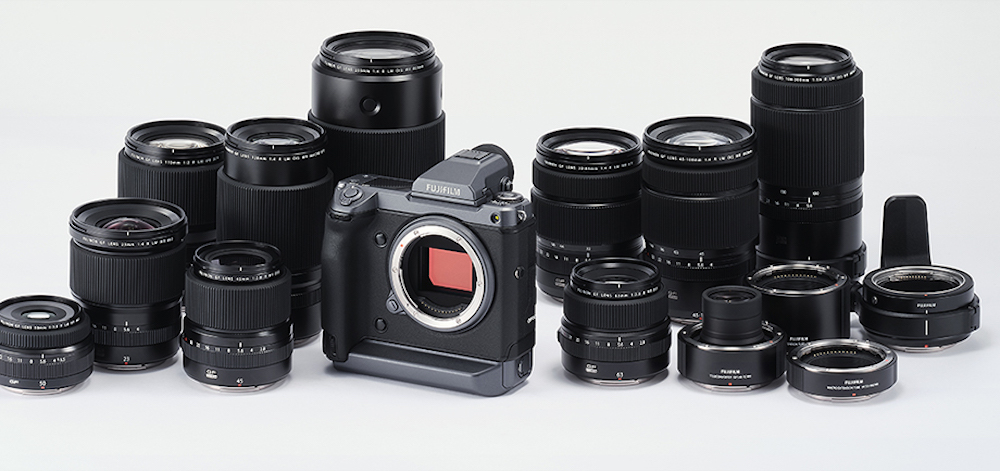
Lorem ipsum dolor sit amet, consectetur adipiscing elit, sed do eiusmod tempor incididunt ut labore et dolore magna aliqua. Ut enim ad minim veniam, quis nostrud exercitation ullamco laboris nisi ut aliquip ex ea commodo consequat. Duis aute irure dolor in reprehenderit in voluptate velit esse cillum dolore eu fugiat nulla pariatur. Excepteur sint occaecat cupidatat non proident, sunt in culpa qui officia deserunt mollit anim id est laborum.
You May Also Enjoy...
Hand’s On: new Sony A9III and Sony 50mm G Master, Sony 85mm G Master, Sony 75-350mm APS lenses
A quick hands on look at Sony A9iii and the Sony APS 75-350mm len
The best wide-angle zoom in the world? The Fujinon G5 20-35mm f4 R WR reviewed.
FUJIFILM GF 20-35mm f/4 R WR L
